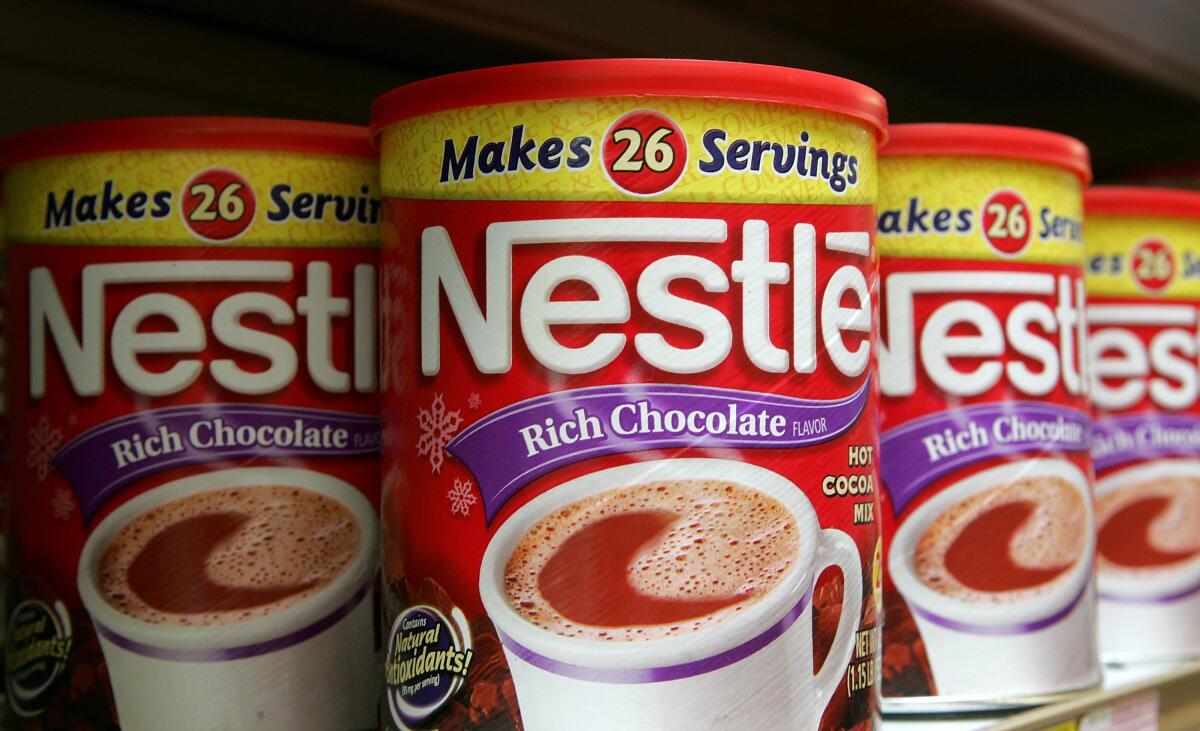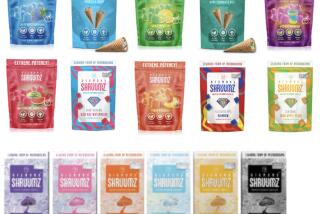Heavy metal drink: Your favorite hot chocolate mix could contain high amounts of lead

- Share via
Before you cozy up on the couch with a mug of your favorite hot chocolate, you might want to consider Consumer Report’s latest list of powder mixes that contain high levels of metal.
Last year, Consumer Reports found that many chocolate bars, including Hershey’s, Theo, Trader Joe’s, Hu and Godiva, had dangerous amounts of lead and cadmium.
The magazine this year expanded its research to test six brands of hot chocolate mixes. The powder mixes that were found to have excessive amounts of lead and cadmium included Great Value Walmart milk chocolate flavor hot cocoa, Starbucks hot cocoa classic, Trader Joe’s organic hot cocoa and Nestlé rich milk chocolate flavor.
The review found that Swiss Miss milk chocolate flavor hot cocoa mix and Ghirardelli premium hot cocoa mix were safer to drink than the others.
Frequent exposure to lead and cadmium has been linked to immune system suppression, reproductive issues, kidney damage and hypertension, according to Brian Ronholm, director of food policy for Consumer Reports.
“If you consume [hot chocolate], you’re not automatically going to experience these health impacts, but it certainly increases your risk of these types of maladies,” he said.
It’s particularly risky for pregnant women and young children, because the metals can cause developmental problems and negative neurological effects, Ronholm said.
A popular Netflix docuseries focuses on ‘Blue Zones,’ where lifestyles centered on faith, community and healthful eating lead to lower rates of chronic disease and greater longevity.
What are metals doing in chocolate?
The soil from which cacao is harvested could contain cadmium, said Ronholm.
“So if the [cadmium] is in the soil already, it gets absorbed into the beans as they grow, and then it ends up in the product,” he said.
Lead could get into the beans after harvest, potentially from dust and soil that lands on the beans as they dry outdoors, the report states.
Both metals were found in the cocoa solids, the component of the bean that, along with cocoa butter, makes up chocolate. Products containing a lot of cocoa solids, such as dark chocolate and cocoa powder, tend to be higher in heavy metals.
Last year’s findings showed that dark chocolate tends to have higher levels of cacao — and thus metals — but other products contain it too, including cocoa powder and milk chocolate. Researchers conducted the test again this year and reached a similar conclusion.
“When we did those tests, we found those worrisome levels of lead and cadmium in the dark chocolate, and that acted as a springboard to do additional testing on chocolate products and expanding the scope of it to include milk chocolate, chocolate chip products and cocoa,” Ronholm said.
If this is dangerous, why is it being sold?
Ronholm said there isn’t a Food and Drug Administration maximum standard for lead or cadmium, or other types of heavy metals, in foods, but it’s something the agency is working on.
The FDA recently identified actions in its Closer to Zero initiative intended to reduce exposure to contaminants such as arsenic, lead, calcium and mercury that can be consumed by children.
California’s standard for maximum allowable dose levels are .5 micrograms per day for lead and 4.1 micrograms per day for cadmium.
External and internal ageism permeates our society. Here’s how to step away from the young is good, old is bad dichotomy and embrace getting older.
It should be noted that such metals are present in the environment and can get into food. For example, lead may be present where food is grown, raised or processed. The Consumer Reports study stated that metals can be found in sweet potatoes, spinach and carrots, so consumers should try to assess and control their intake.
In the meantime, when you’re deciding which hot chocolate mix to buy, be warned that there isn’t a label or ingredient indication that lead is in the product.
“Consumers shouldn’t panic; they should still enjoy these products,” Ronholm said “We all do, even those of us who work at Consumer Reports certainly enjoy those products.”
He reminded hot chocolate lovers to enjoy the drink in moderation.
“So it’s critically important for that population to make sure that they’re limiting their intake and being very selective as to which products they choose to consume,” Roholm said.
More to Read
Sign up for Essential California
The most important California stories and recommendations in your inbox every morning.
You may occasionally receive promotional content from the Los Angeles Times.













